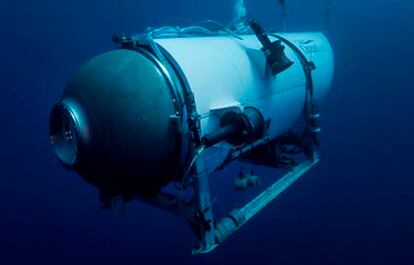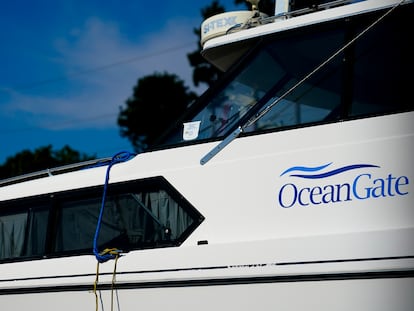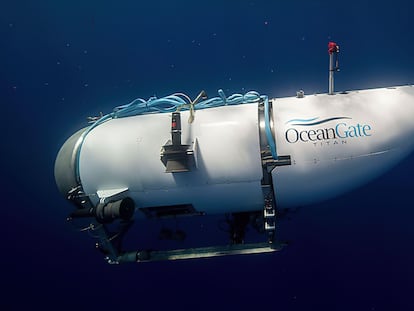The ‘Titan’ implosion will be investigated by an international group of agencies
Investigators from the U.S., Canada, France and the United Kingdom are working closely together on the probe of the June 18 accident

An international group of agencies is investigating what may have caused the Titan submersible to implode while carrying five people to the Titanic wreckage, and U.S. maritime officials say they’ll issue a report aimed at improving the safety of submersibles worldwide.
Investigators from the U.S., Canada, France and the United Kingdom are working closely together on the probe of the June 18 accident, which happened in an “unforgiving and difficult-to-access region” of the North Atlantic, said U.S. Coast Guard Rear Adm. John Mauger, of the Coast Guard First District.
Salvage operations from the sea floor are ongoing, and the accident site has been mapped, Coast Guard chief investigator Capt. Jason Neubauer said Sunday. He did not give a timeline for the investigation. Neubauer said the final report will be issued to the International Maritime Organization.
“My primary goal is to prevent a similar occurrence by making the necessary recommendations to advance the safety of the maritime domain worldwide,” Neubauer said.
Evidence is being collected in the port of St. John’s, Newfoundland, in coordination with Canadian authorities.
All five people on board the Titan were killed. Debris from the vessel was located about 12,500 feet (3,810 meters) underwater and roughly 1,600 feet (488 meters) from the Titanic on the ocean floor, the Coast Guard said last week.
The search is taking place in a complex ocean environment where the Gulf Stream meets the Labrador Current, an area where challenging and hard-to-predict ocean currents can make operations such as controlling an underwater vehicle more difficult, noted Donald Murphy, an oceanographer who served as chief scientist of the Coast Guard’s International Ice Patrol.
“The dynamics of area make it difficult to do any kind of operation at the surface,” Murphy said. “There can be quite vigorous currents down there.”
The early summer is the best time to be conducting this type of operation because of the lower likelihood of storms, but it’s still likely to be painstaking, Murphy said.
It’s not impossible, however. Working in their favor: The ocean bottom where they are searching is smooth and not near any of the Titanic debris, said Carl Hartsfield of the Woods Hole Oceanographic Institute.
Authorities are still trying to sort out what agency or agencies are responsible for determining the cause of the tragedy, which happened in international waters.
OceanGate Expeditions, the company that owned and operated the Titan, is based in the U.S. but the submersible was registered in the Bahamas. Meanwhile, the Titan’s mother ship, the Polar Prince, was from Canada, and those killed were from England, Pakistan, France, and the U.S.
A key part of any investigation is likely to be the Titan itself. The vessel was not registered either with the U.S. or with international agencies that regulate safety. And it wasn’t classified by a maritime industry group that sets standards on matters such as hull construction.
The investigation is also complicated by the fact that the world of deep-sea exploration is not well-regulated. OceanGate CEO Stockton Rush, who was piloting the Titan when it imploded, had complained that regulations can stifle progress.
On Saturday, the Transportation Safety Board of Canada said it has begun an investigation and has been speaking with those who traveled on the Polar Prince. Board chairperson Kathy Fox said officials will share information it collects with other agencies, such as the U.S. National Transportation Safety Board, which is taking part in the overall investigation.
The Royal Canadian Mounted Police said Saturday that it will conduct a full investigation only if it appears criminal, federal or provincial laws were broken.
If it chooses to do so, the Coast Guard can make recommendations to prosecutors to pursue civil or criminal sanctions. Questions about the submersible’s safety were raised both by a former company employee and former passengers. Others have asked why the Polar Prince waited several hours after the vessel lost communications to contact rescue officials.
Coast Guard officials have not indicated whether they will take that route.
The Polar Prince, towing the ill-fated Titan, left Newfoundland on June 16. There were 41 people on board: 17 crew members and 24 others, including the five-man Titan team.
After the vessel lost communication, the Coast Guard led the initial search and rescue mission, a massive international effort that likely cost millions of dollars. Questions have also arisen about possible reimbursement for rescue agencies, but the Coast Guard doesn’t charge for searches “nor do we associate a cost with human life,” Mauger said.
The Titan launched at 8 a.m. June 18 and was reported overdue that afternoon about 435 miles (700 kilometers) south of St. John’s. Rescuers rushed ships, planes and other equipment to the area.
Any sliver of hope that remained for finding the crew alive was wiped away early Thursday, when the Coast Guard announced debris had been found near the Titanic.
Killed in the implosion were Rush; two members of a prominent Pakistani family, Shahzada Dawood and his son Suleman Dawood; British adventurer Hamish Harding; and Titanic expert Paul-Henri Nargeolet.
Sign up for our weekly newsletter to get more English-language news coverage from EL PAÍS USA Edition
Tu suscripción se está usando en otro dispositivo
¿Quieres añadir otro usuario a tu suscripción?
Si continúas leyendo en este dispositivo, no se podrá leer en el otro.
FlechaTu suscripción se está usando en otro dispositivo y solo puedes acceder a EL PAÍS desde un dispositivo a la vez.
Si quieres compartir tu cuenta, cambia tu suscripción a la modalidad Premium, así podrás añadir otro usuario. Cada uno accederá con su propia cuenta de email, lo que os permitirá personalizar vuestra experiencia en EL PAÍS.
¿Tienes una suscripción de empresa? Accede aquí para contratar más cuentas.
En el caso de no saber quién está usando tu cuenta, te recomendamos cambiar tu contraseña aquí.
Si decides continuar compartiendo tu cuenta, este mensaje se mostrará en tu dispositivo y en el de la otra persona que está usando tu cuenta de forma indefinida, afectando a tu experiencia de lectura. Puedes consultar aquí los términos y condiciones de la suscripción digital.
More information
Archived In
Últimas noticias
Most viewed
- Reinhard Genzel, Nobel laureate in physics: ‘One-minute videos will never give you the truth’
- Oona Chaplin: ‘I told James Cameron that I was living in a treehouse and starting a permaculture project with a friend’
- Pablo Escobar’s hippos: A serious environmental problem, 40 years on
- Why we lost the habit of sleeping in two segments and how that changed our sense of time
- Chevy Chase, the beloved comedian who was a monster off camera: ‘Not everyone hated him, just the people who’ve worked with him’










































